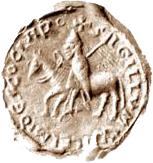The Davies family
William Davies, FGS
William Davies was born on 13 July 1814 at Holywell, Flintshire. He joined the staff of the British Museum in 1843 and after working on the mineral collection, turned his attention to fossil fishes and then to vertebrate fossils generally. He became so skillful at reconstructing extinct forms of life that he took charge of the entire vertebrate fossil collection in 1875, with a rank equivalent to that of an Assistant Keeper today.
In 1880, he assisted with the removal of the natural history collections from Bloomsbury to South Kensington. The Natural History Museum owes some of its most important specimens to his skill in the disinterment of such remains and their reconstruction from apparently worthless fragments.
He published little, being of a retiring disposition and more interested in his official duties, but fifteen short but important contributions appeared in the Geological Magazine and the Quarterly Journal of the Geological Society. His indirect contributions to published works are indicated by the references to the help given by him in the publication of the British Museum catalogues of fossil fishes, reptiles and mammals, and in the account of the carboniferous fossils of Belgium by L. G. de Koninck.
In 1873, he received the first award of the Murchison medal founded by the Geological Society, and four years later was elected a Life Fellow of the Society. He continued working for the museum by revising proofs of palaeontological publications after his retirement in 1887. He died at Labdens, Colliers End, Hertfordshire, on 13 February 1891.
Thomas Davies, FGS
Thomas Davies was William’s son, although it is not known whether he had any other children. Thomas was born at St. Pancras on 29 December 1837. He went to sea when he was 14 years old and travelled widely, visiting China, India and various parts of South America. His father convinced Thomas to join him at the British Museum, where he worked on the Mineral Collection under Professor Story-Maskelyne. There he became an experienced mineralogist and was a pioneer in the use of the microscope in the study of rocks. In 1889, the mineral ‘Daviesite’ was named after him. In 1870 he was elected a Fellow of the Geological Society and was an early member of the Mineralogical Society of France. He was an original member of the Mineralogical Society and served as its foreign secretary prior to his death. In 1880 he was appointed 1st Class Assistant in the Department of Mineralogy.
Like his father, Thomas was more interested in his official duties than publishing the results of his work, but he did make a few contributions to the Quarterly Journal of the Geological Society, the Geological Magazine and The Mineralogical Magazine, the last of which he edited for several years. When he died on 21 December 1892, just one year after his father, the museum set up a “Thomas Davies Memorial Fund” with Story-Maskelyne, the Keeper of Mineralogy, as its chairman. The Mineralogical Magazine published an obituary in which the following was written (see below for a pdf download):
His love of fresh air and the bustling east wind never left him: even after recovery from the long illness which two years ago had taken him to the verge of the grave, and from which he never fully recovered, he did not hesitate to show his former contempt for the protection of an umbrella, and notwithstanding the remonstrances of his friends might occasionally be seen still enjoying the beating of the wind and rain on his unprotected face.
Thomas married and had nine children: Emma Esther and Eliza Kate (Kit), Jennie (Jane), Mary, Ellen (Nell), William, George, Walter and Frank. The sisters Emma Esther and Eliza Kate married two brothers: respectively, Albert Frederick Brown and Harold Brown. Frederick and Emma had three children, Alec, Olive and Norah. They lived at Gordon House, Wembley, and it was in Wembley that Norah met Eric Gerald Alexander Sinclair, who, despite warnings not to associate with the rough Sinclair boys, she chose to marry. Harold and Kate had six children, one of whom was Tom Brown, who wrote several children’s books under the name of T. Barton Brown. Tom’s son Peter was killed in an aircraft accident, which Tom learnt about when he chanced to read someone’s evening newspaper on the train home from work.
For much of the above information about the professional lives of William and Thomas Davies thanks must go to the Archives at the Natural History Museum and to Frederick John North (1889-1968), the author of contributions to Welsh Biography Online.


